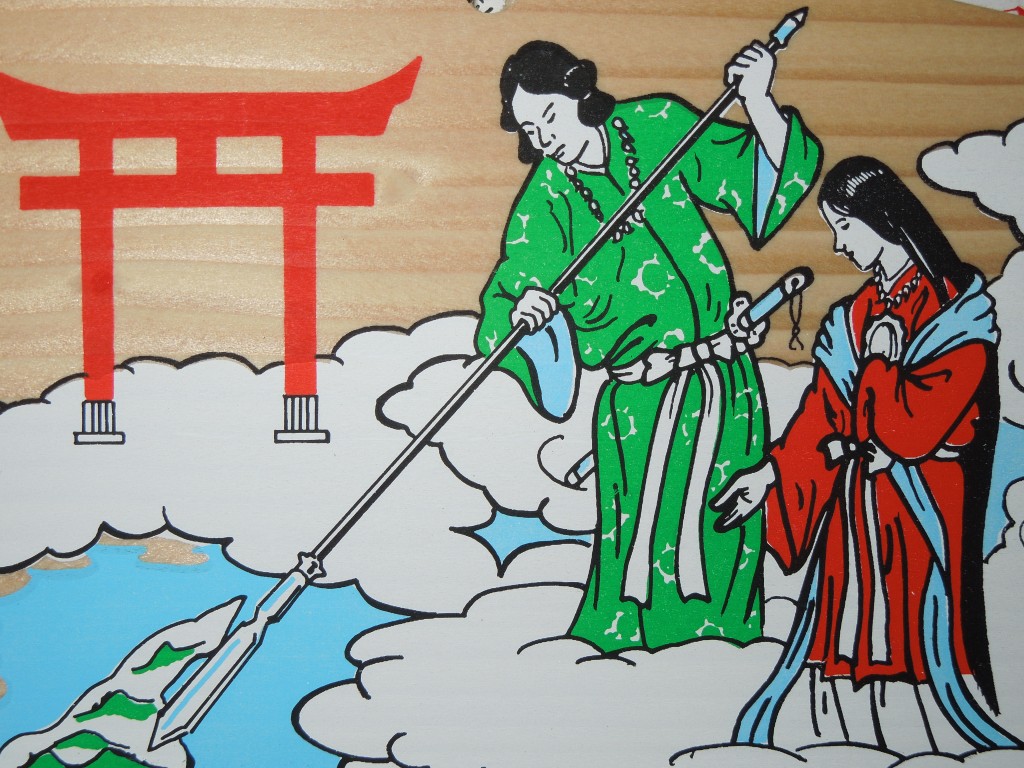
Creation of the world by Izanagi and Izanami
Origins
In the late seventh century Emperor Tenmu ordered Are of the Hieda clan to learn by heart the old traditions which were in danger of being lost or ‘interpreted wrongly’. Clearly the intention was to shape the existing myths to fashion an ideology that supported the ruling families. Whether Are was a man or woman is not known, but the 28-year old apparently had a photographic memory and completed the task.
Later, in the reign of Empress Genmei, Hieda no Are’s version was written down by O no Yasumaro. In his own words, he was ‘commanded to select and record the old words.’ To do so, he employed a mixed form of phonetic and semantic Chinese characters. To later ages it was unreadable, and the text became a little-known house text of the ruling imperial family. The Nihon shoki, published in 720 just eight years after the Kojiki, was more widely circulated.

Motoori Norinaga at his wriiting desk
Motoori Norinaga
The man who rescued the Kojiki from obscurity was a philologist named Motoori Norinaga (1730-1801). In the latest edition of Japanese Religions (Vol. 36 Nos. 1-2), Klaus Antoni examines the motivations and effect of Norinaga’s work. The primary purpose of the eighteenth-century scholar was to render the archaic language of Kojiki into intelligible Japanese, but to do so he had to enter imaginatively into the text, for the meaning was often hidden behind phonetic renderings of obsolete words.
In his interpretation of the text, Antoni suggests, Norinaga was guided by a strong desire to show Japan’s superiority to the hated Chinese. For Norinaga the Chinese were characterised by selfishness, in contrast to the communal Japanese who put social harmony before self. Moreover, the Chinese were reliant on rationality, as evidenced by Confucianism, whereas the more sincere Japanese did not need systems of morality since they had a natural sense of goodness.
Norinaga’s purpose was thus to show the superiority of Japan, and he found the means of proving this in the Kojiki. The creation of the country and the divine descent of the emperor made Japan a ‘kami no kuni’ (land of the kami). He therefore interpreted passages of the text as he wanted them to be – ‘one must determine language through intuition,’ he noted.
Legacy
Through his lifework, Norinaga not only asserted the centrality of Kojiki to the national canon, but gave powerful backing to the movement to restore the authority of the emperor. The mythology he championed was later taken up by the Meiji government as its ruling ideology, and it became the key text for State Shinto in the early twentieth century. ‘But it would be a mistake to see Norinaga’s opinions as the basis for canonization of the Kojiki in the modern period,’ writes Konoshi Takamistsu. ‘Instead it was the modern state’s need for a national canon that caused it to discover Norinaga.’
Still today Norinaga’s legacy shapes contemporary Shinto, but there are good reasons for thinking that Nihon shoki better meets the demands of the age. It is a more historical work and offers competing versions of the same episodes. And since it was written in a comprehensible script, it has not had to be filtered through the eighteenth-century consciousness of a man with an anti-Chinese agenda.
*************************************************************************************************************************************************
Information draws on ‘Creating a Sacred Narrative: Kojiki Studies and Shinto Nationalism’ by Klaus Antoni in Japanese Religions Vol 36, Nos. 1 and 2 (Spring and Fall, 2011), p.3-30.

Leave a Reply